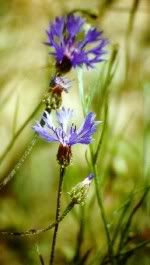

Bachelor's Buttons (Centaurea cyanus)
Folk Names: Blue Cap, Blue Centaury, Blueblow, Bluebonnet, Bluebottle, Bluet (French), Cornflower, Cyani, Devil's Flower, Hurtsickle, Red Campion
Description: Bachelorís Button is an annual native to the Mediterranean and Europea, and naturalized to North America. The thin, stiff, branched stem grows from one to two feet. The plant is wooly and white when young. The alternate, grayish-green leaves are long and narrow pinnate. They are lobed near the base and nearly filiform near top. The large, terminal thistle-like flower is usually blue, but there are white, rose, purple, and mauve varieties. The flowers appear June through August and may be up to one and one-half inches.
Effects: gentle
Planet: Venus, Saturn
Element: Water
Associated Deities: Robin Goodfellow, Chiron, Flora
Traditions:
Bachelorís Buttons are particularly sacred on Floralia which occurs near Beltane. The flower was a favorite of Cyanus, a devotee of Flora, from whom is takes its name. Its genus was derived from Chiron, perhaps one of the most famous centaurs, who taught mankind healing arts.
If the flower petals are pressed, they express a blue juice. While this is not suitable as a dye (it fades), it may be used as a natural ink for your book of shadows. (See mercantile usage)
Magic:
A bachelorís button flower should be worn over the heart to attract the love of a man. For love divination, carry a flower in your pocket. It will lose or retain its freshness according to the success of you amatory pursuits.
it is said people who have cornflower blue eyes will find special protection for their eyes in this plant. Filtered through three layers of blue linen and consecrated under a full moon with a moonstone, a wash of bachelorís button flowers may be used to bathe the eyes to increase clairvoyance.
Though called cornflower, bachelorís buttons are actually antithetical to the growth of corn, using up the nutrients in the earth. It was also called hurtsickle because in the days of hand reaping, the tough stem blunted the reaperís sickle. For these reasons, it might be best to avoid any combinations with corn or harvest spells.
Known Combinations:
According to Culpepper, Bachelorís Buttons combined with Plantain, Horsetail, or Comfrey is a remedy against all ďvenoms and poisons.Ē The seeds or leaves, taken in wine, are said to be a cure for plague and other infectious diseases.
Medical Indications: Parts Used: flower
Bachelorís Button contains tannin, and it is therefore astringent. Ancient writers suggested its use in closing wounds and treating bruises. It is also a diuretic and tonic. It is used to treat dyspepsia, and the flowers have long been used in eyewashes, eye drops, and compresses for eyes.
Nutrition:
inedible
Mercantile Uses:
Combine the juice of the flowers with alum for blue ink. You may also use it for water colors.
Bachelorís buttons are popular garden flowers. The dried flowers may be included in potpourris, though mainly for color, and they also make lovely additions to wreaths and floral arrangements.